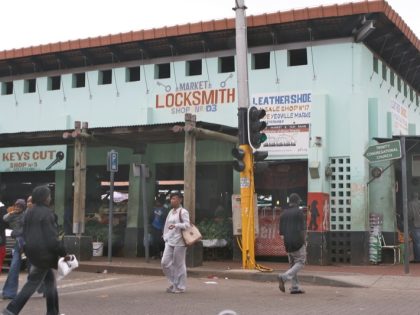Elisofon’s Africa
The photographer, Elliot Elisofon's 'choice' of what to see and how was embedded in a visual colonial archive. It was never a unique choice.

Elisofon at work.
The photographer, Eliot Elisofon, did not cast “new light” or “refine Africa in a new and a complex way for American audiences,” as claimed in Susan Stamberg’s “‘Life’ Photographer Showed Africa Through a New Lens” on National Public Radio (February 10, 2014) about an exhibit of Elisofon’s work at the Museum of African Art in Washington D.C. His subjectivity and artistic talent was of another sort. Any photograph that Elisofon took for LIFE (and also post-LIFE, 1966-1972) was the result of an array of interlaced pulls. It was informed by the contextual material that he culled from various impromptu sources, by what the LIFE editors supplied him with, and, in particular, by the normative colonial practices that related to the visualization of the ‘African’ body and the ‘African’ landscape. His ‘choice’ of what to see (and how) was embedded in a visual colonial archive of long standing. It was never a unique choice.
To un-mask the mask or the “unfamiliar world” (Africa), he re-masked it by bringing it home — at costs for Africa. “Life’s special gift,” explains Wendy Kozol (in LIFE’s America: Family and Nation in Postwar Photojournalism), “was to make change seem traditional by locating the tensions of an unfamiliar world within the seemingly familiar and nonthreatening orbit of the ‘happy’ nuclear family.” It is from within this political parameter of the curative ‘happy American family’ that Elisofon’s applied pedagogy became a lucrative business.
His photographs are confirmations and refinements of ‘the-already-seen’ for an audience that he/LIFE believed needed his/their guidance and clarification. This was to be his gift. Colonial travel or missionary travel, such as his famed 1947 ‘Tour of Africa,’ the trip from Cape Town to Cairo, was double-faced, as each of his eleven trips were. It privileged the return, from the outer (Africa) to the inner (the U.S.). His travels were circuits, their destination was the U.S., not Africa. His photographs are not about Africa, they are about Africa in America!
Ever since Leopold II’s time, the Bakuba Kingdom was the established destination for Western anthropologists, explorers and photographers in their pursuit of what the area could offer of decorated drums, raffia cloths, and fine pottery. But more importantly, it hosted relative exemption from colonial restrictions that gave the visitors access to the Kuba King in Mushenge, a colonial handyman who, at Eliot’s visit, was Mbop Mabiinc maKyen (see the photo in Stamberg’s review captioned as “Portrait of Kubanyim Mbopey Mabiintsh ma‐Kyeen, taken in 1947 in Mushenge, Congo”).
He was a king who knew his price. Elisofon was out for the ‘authentic’ and the ‘untouched,’ but he was always ready to compromise these ideals, when his camera caught what he thought might attract an American eye (that was male). He took hundreds of photos during the two days he stayed in the King’s village, half of them focusing on a dancing session and the leader surrounded by his “harem of 350 wives.” These are his own words about what he wanted to see:
The leader had a special gourd which had a necklace of tinkling objects around its neck. She set the rhythm for the others. The others … all kinds … fat and skinny, tall and short, young and old, smooth and wrinkled, some with breasts so pendulant that they were revolting to see, backs and stomachs tattooed in intricate beautiful patterns, a touch of tattoo near the forehead, some with clean shaven hands, other with tight black curls, and all wearing the attire of the harem [the ruler’s entourage of wives], an orange wrap around skirt with a billowy edging. … I got tired of photographing old hags with horrible figures and picked out a nice young one with a fine figure, only she said she couldn’t dance.
Customarily, the king and the photographer exchanged gifts. The king offered Elisofon an old pipe with a man’s head for the bowl, a cup in the shape of a hand, and several boxes covered with intricate designs and animals in relief. He was laying the ground for his collection of African artifacts that eventually would amount to 700 pieces, now at the National Museum of African Art in Washington. Elisofon, in his turn, gave the king a “a gold-looking heavy neck-chain that cost exactly forty-nine cents” at Woolworths, a camera and 500 francs. This lopsided mode of bargaining was a colonial norm that Elisofon practiced whenever he had a chance.
The re-invented photographies of the Kuba clan (with the freakish depiction of him as “African Big Shot. A Fat Black Monarch of the Congo,” LIFE, March 31, 1947), and the denigrating one-liners that accompanied them, were returned ‘home,’ and being re-published (with them also the support from the condescending captions) and robbed of their context, were/are continuously distancing African cultural and historical conditions, in fact revisiting their racist mythologies.
A couple of months later, during the same 1947 Tour, he spent some time with two British colonial families (the Pitt-Moore family and Lord and Lady Hamilton) in British Kenya, shooting family pictures of a kind that, it seems, did not require any curative interference. These pictures have not been published (as far as I can see), for that reason. Elisofon’s idea was to “make a simple coverage of the English way of life in an African setting.” It so happened that this “life” as well as the “life” that gave him an opportunity to photograph the Kuba king was colonial, a system that he benefited from, and never problematized in visual terminology.
As a contrast, see the sober, unsentimental photo by Arnold Newman, a colleague of Elisofon, “Bope Mabinshe King Of The Bakubas Congo Africa 1958”:



















